| Pages:
1
..
4
5
6
7
8 |
blargish
Hazard to Others
  
Posts: 166
Registered: 25-9-2013
Location: Canada
Member Is Offline
Mood: Mode Push
|
|
Cool to see this thread back in business! Thought I might as well show off my own malachite/azurite sample 

Also, here is an interesting rock that I found at an old volcanic plug a couple years ago. I have an idea of what it may be, but I want to see what
others think
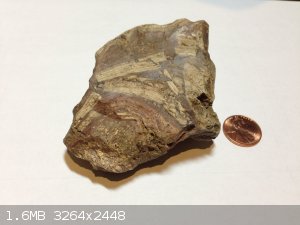 
BLaRgISH
|
|
|
aga
Forum Drunkard
    
Posts: 7030
Registered: 25-3-2014
Member Is Offline
|
|
The layers in the bottom left photo are fascinating.
It looks (to me) as if there was a thin tube in a volcano and the molten rock was pushing & melting some other rock stuff up as it went, yet
cooled into that form at some point.
Edit:
Or the layered bits are the sedimentary Surface rocks and the lower bit is the last bit of molten volcano rock to buckle it through a small
hole/weakness.
[Edited on 24-7-2015 by aga]
[Edited on 24-7-2015 by aga]
|
|
|
diddi
National Hazard
   
Posts: 723
Registered: 23-9-2014
Location: Victoria, Australia
Member Is Offline
Mood: Fluorescent
|
|
nice malachite/azurite. looks like the sort of stuff from chinese mines.
the other specimen looks like chert to me
Beginning construction of periodic table display
|
|
|
blargish
Hazard to Others
  
Posts: 166
Registered: 25-9-2013
Location: Canada
Member Is Offline
Mood: Mode Push
|
|
Yea aga, the white layers and brecciated fragments where what really caught my eye at first.
I believe that the rock is a rheomorphic welded ignimbrite: a rock formed by the deposition of a pyroclastic flow. If I'm correct, the white fragments
in it are known as fiamme, which are pumice fragments that were elongated and brecciated due to the overlying hot ash/rocks. The interesting thing for
me is that so called "rheomorphic flow" structures can be seen in the rock (notably in the second picture) where the pyroclastic deposit was able to
flow in a fluid-like manner.
Diddi, you're right. The malachite/azurite is from china, although I'm uncertain of its exact locality.
[Edited on 27-7-2015 by blargish]
BLaRgISH
|
|
|
diddi
National Hazard
   
Posts: 723
Registered: 23-9-2014
Location: Victoria, Australia
Member Is Offline
Mood: Fluorescent
|
|
nice volcanic specimen blargish. did you collect it yourself
Beginning construction of periodic table display
|
|
|
blargish
Hazard to Others
  
Posts: 166
Registered: 25-9-2013
Location: Canada
Member Is Offline
Mood: Mode Push
|
|
Yea, I found it a few years back around an old volcanic plug called Giant's Head on Canada's west coast (BC). The whole area is littered with these
crazy smooth volcanic bombs which are locally called cannonballs. I'll get a pic of one that I collected if I can find where I put it...
BLaRgISH
|
|
|
diddi
National Hazard
   
Posts: 723
Registered: 23-9-2014
Location: Victoria, Australia
Member Is Offline
Mood: Fluorescent
|
|
very good. you might have to do some collecting for me 
Beginning construction of periodic table display
|
|
|
diddi
National Hazard
   
Posts: 723
Registered: 23-9-2014
Location: Victoria, Australia
Member Is Offline
Mood: Fluorescent
|
|
heres a pretty pic for you.... crystalline Stibnite (Sb2S3)
this is crushable and dissolves in acids!

Beginning construction of periodic table display
|
|
|
blargish
Hazard to Others
  
Posts: 166
Registered: 25-9-2013
Location: Canada
Member Is Offline
Mood: Mode Push
|
|
Wow, that's a solid piece; did you find it yourself? I lack stibnite in my own collection, but it's still one of my favs.
Here's a fragment of one of those volcanic bombs. I believe the black spots are hornblende. It's really smooth; feels almost like it's been machined.
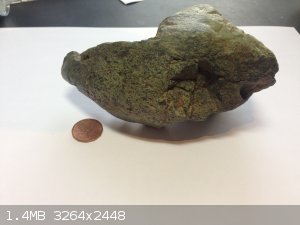
Additionally, here are a couple rocks from a trip to Mt. Vesuvius. The first one is a tephrite (which are found all over the place) and I believe the
second to be a leucitite. Both have some nice phenocrysts (augite/leucite in the tephrite, and leucite in the leucitite).
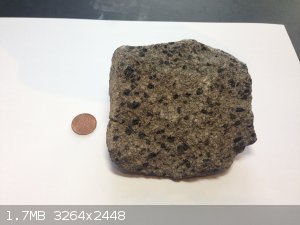 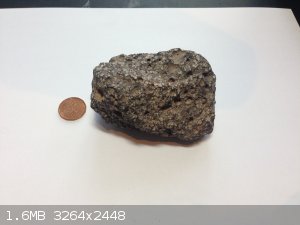
BLaRgISH
|
|
|
diddi
National Hazard
   
Posts: 723
Registered: 23-9-2014
Location: Victoria, Australia
Member Is Offline
Mood: Fluorescent
|
|
very nice. the stibnite is a purchase. around here there is a lot of massive stibnite, but no xtals 
not sure that that is a hornblende? the black crystals should be rectangular. yours look spherical?

local hornblende from Dookie, Victoria, Aust.
Beginning construction of periodic table display
|
|
|
blargish
Hazard to Others
  
Posts: 166
Registered: 25-9-2013
Location: Canada
Member Is Offline
Mood: Mode Push
|
|
A good number of the crystals are bladed and have hexagonal habit as far as I can tell. As for those that don't, I have seen hornblende take on a
blocky appearance, in contrast to its classic needly appearance seen in your specimen (really nice btw), similar to pyroxenes in other samples, which
can make it very confusing...
Here is just an example from the web; a hornblende porphyritic basalt which appears very similar to my own rock.
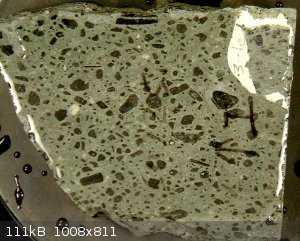
source: https://instruct.uwo.ca/earth-sci/200a-001/200lab3.htm
I could be wrong though as I am by no means an expert  ; it could certainly be
pyroxenes or something else. I find it hard to distinguish all the black blocky/rectangular mineral thingies on looks alone. I guess getting a sense
of its cleavage would give me an answer, although it would be hard due to the small size of the crystals ; it could certainly be
pyroxenes or something else. I find it hard to distinguish all the black blocky/rectangular mineral thingies on looks alone. I guess getting a sense
of its cleavage would give me an answer, although it would be hard due to the small size of the crystals
[Edited on 31-7-2015 by blargish]
BLaRgISH
|
|
|
diddi
National Hazard
   
Posts: 723
Registered: 23-9-2014
Location: Victoria, Australia
Member Is Offline
Mood: Fluorescent
|
|
yes, so many of these minerals are both highly variable and part of a spectrum of alterations. I have a number of pieces if that mineral from same
location but all quite different.
Beginning construction of periodic table display
|
|
|
Eddygp
National Hazard
   
Posts: 858
Registered: 31-3-2012
Location: University of York, UK
Member Is Offline
Mood: Organometallic
|
|
Although I posted this in a separate thread a while ago, it was never completely identified, so here it goes. This rock has been discovered along with
other apparently pure, blobby metal fragments coated in a hard red oxide shell (which led me to think that it is iron, but -whaaaat?!- it is not
attracted to magnets!!!).
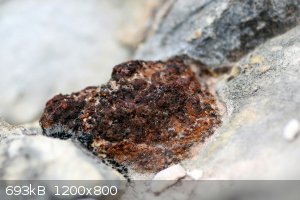 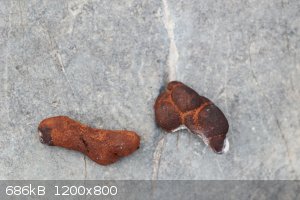 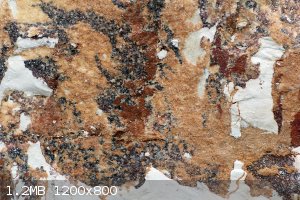
there may be bugs in gfind
[ˌɛdidʒiˈpiː] IPA pronunciation for my Username |
|
|
diddi
National Hazard
   
Posts: 723
Registered: 23-9-2014
Location: Victoria, Australia
Member Is Offline
Mood: Fluorescent
|
|
not all iron bearing rocks are magnetic. these are hard to identify without cutting or magnification. #1 cant say? #2 could be an iron stained
limestone consecration? #3 looks like moss/lichen on a stone wall ?
Beginning construction of periodic table display
|
|
|
Eddygp
National Hazard
   
Posts: 858
Registered: 31-3-2012
Location: University of York, UK
Member Is Offline
Mood: Organometallic
|
|
Quote: Originally posted by diddi  | | not all iron bearing rocks are magnetic. these are hard to identify without cutting or magnification. #1 cant say? #2 could be an iron stained
limestone consecration? #3 looks like moss/lichen on a stone wall ? |
#2 is most probably pure metal/metal oxide, due to very high density compared to limestone. By the way, those blobs were found separate from the rock.
#3 is not lichen, also iron
The iron mineral is found along crevices and grooves in the limestone rock, as well as those blobs such as #2.
[Edited on 23-8-2015 by Eddygp]
there may be bugs in gfind
[ˌɛdidʒiˈpiː] IPA pronunciation for my Username |
|
|
diddi
National Hazard
   
Posts: 723
Registered: 23-9-2014
Location: Victoria, Australia
Member Is Offline
Mood: Fluorescent
|
|
yeh, they are really hard to work out by pics. sorry.
where are they from
[Edited on 23-8-2015 by diddi]
Beginning construction of periodic table display
|
|
|
Morgan
International Hazard
    
Posts: 1705
Registered: 28-12-2010
Member Is Offline
Mood: No Mood
|
|
I found this "rock" in the middle of some railroad tracks when walking this morning near some bluffs. It's very attracted to a magnet and heavy. I
didn't see any slag pictures in Google images that resembled it but the way it formed looks curious. It's very friable so it seems odd that the edges
are still in one piece or that it doesn't looked like it could have been knocked around too much if it fell off a train. I didn't see any other pieces
like this rock when I looked for more.
 
|
|
|
aga
Forum Drunkard
    
Posts: 7030
Registered: 25-3-2014
Member Is Offline
|
|
At a guess, i'd say it was iron & lubricant oil that has built up over a long period of time on a train.
Iron & oils form a kind of rubbery material over a long period of time, which might be why some of it remained intact when it fell off.
Break a small piece off and try to set fire to it.
|
|
|
Morgan
International Hazard
    
Posts: 1705
Registered: 28-12-2010
Member Is Offline
Mood: No Mood
|
|
It didn't smoke or reduce at all when heated with a butane torch - it just glowed after heating for a few seconds. It almost looks like fine iron grit
that has fused together somehow while being in a draft or from gravity. A woman I passed on the trail said it looked like a Christmas tree, I think
because of the way it looks swept as it was formed.
Trains drop sand under their wheels sometimes to provide traction when starting and I wonder if fine metal particles from the rail could collect or
fuse together this way after being abraded off? Or maybe the rock is some sort of ore or scrap slag-like material that just fell off the train but it
was right in the middle of the tracks. As you say it seems like something that formed under the train and fell off though but I don't know.
|
|
|
aga
Forum Drunkard
    
Posts: 7030
Registered: 25-3-2014
Member Is Offline
|
|
Brake residues ?
Iron grinding against iron a lot maybe - the heat could fuse the particles, possibly.
I googled 'Train Brake Turd' and there were no relevant results.
|
|
|
Morgan
International Hazard
    
Posts: 1705
Registered: 28-12-2010
Member Is Offline
Mood: No Mood
|
|
Maybe it's something inbetween a stalagtite and stalagmite, if there's a word for one that forms in the horizontal from iron particle ejecta.
|
|
|
aga
Forum Drunkard
    
Posts: 7030
Registered: 25-3-2014
Member Is Offline
|
|
Aggregate particulate matter or something like that ?
|
|
|
Morgan
International Hazard
    
Posts: 1705
Registered: 28-12-2010
Member Is Offline
Mood: No Mood
|
|
It looks like iron particles that have been sintered or another thing that comes to mind is some sort of likeness to an electrode growth that grew in
solution but that's a long shot.
|
|
|
chemrox
International Hazard
    
Posts: 2961
Registered: 18-1-2007
Location: UTM
Member Is Offline
Mood: LaGrangian
|
|
I would call this discussion an "igneous intrusion" (even if it flows along near the surface...)
CRBG- look it up
"When you let the dumbasses vote you end up with populism followed by autocracy and getting back is a bitch." Plato (sort of)
|
|
|
IrC
International Hazard
    
Posts: 2710
Registered: 7-3-2005
Location: Eureka
Member Is Offline
Mood: Discovering
|
|
Morgan keep it away from water and never feed it after midnight.
"Science is the belief in the ignorance of the experts" Richard Feynman
|
|
|
| Pages:
1
..
4
5
6
7
8 |